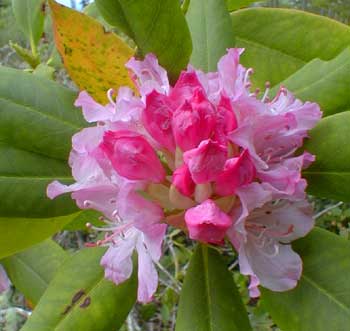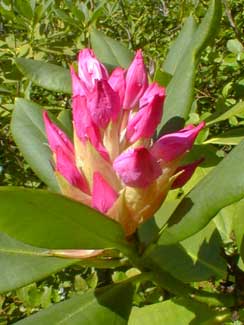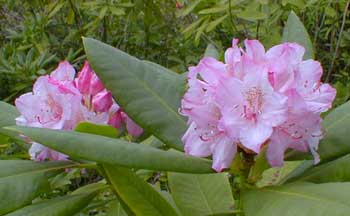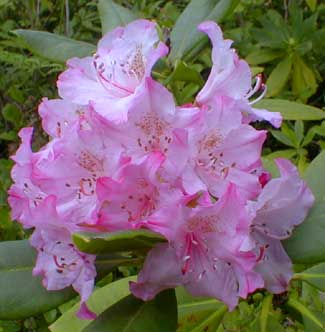
Pacific or Coast Rhododendron
"The spotted ounce
and playsome cubs
Run rustling 'mong
the flowering shrubs."
-Christopher Smart
(1722-1770)
(1722-1770)
Rhododendron macrophyllum is our native Northwest evergreen rhody, large & beautiful, pink-flowering in late April & all of May.
The Pacific or Coast rhododendron is one of the most spectacular wild shrubs in our local woodland areas. As an enormous understory shrub beneath Douglas firs & western cedars & hemlocks, they tend to develop with a tall very loose structure, baring lots of trunk & limb, & can be the very opposite of dense or compact. But this varies a lot & especially at sunny forest edges or under garden conditions they can be much more compact.
 The woods near us have many wild specimens, twisted & rugged ones old & festooned with mossy white lichens, or smaller & more densely upright & leafy. When the main grounds of an estate I help maintain were originally landscaped, many old wild rhodies were fortunately preserved, as they formed beautiful native arrangements together with evergreen huckleberry & salal.
The woods near us have many wild specimens, twisted & rugged ones old & festooned with mossy white lichens, or smaller & more densely upright & leafy. When the main grounds of an estate I help maintain were originally landscaped, many old wild rhodies were fortunately preserved, as they formed beautiful native arrangements together with evergreen huckleberry & salal.The majority of Coast Rhododendrons bloom pale pink, but rich pink specimens exist, as do nearly white. The species though underutilized in breeding programs has nevertheless given rise to several interesting hybrids, one of the best known being 'Albert Close.'
The first important breeders who focused on this species knew it from the woods around their own rhody fields, Vancouver Island hybriders George Fraser & John Blair, early in the 20th Century.
The Coast or Pacific Rhody is also known as California Rosebay, though California has no special claim on it, & it is the State Flower of Washington. It grows from British Columbia to Monterey. Rhododendron Lake near Nanaimo on Vancouver Island was formerly called Kamia Lake, but renamed in 1978 specifically to honor this gorgeous shrub, which is actually rather uncommon the island except around the lake.
It is especially prevelant in our county (Kitsap) & we spot it everywhere along both sides of the Hood Canal. It grows along the coastal side of Cascades in Washington & Oregon. It grows from sea level to a thousand feet, with some populations much higher in the Cascades.
 In a lot of their range they have disappeared due to decades of poaching, which still persists. But we're pretty lucky in Kitsap County that we can see them numerous & flowering every May even along the highway, wherever large trees remain to shelter them.
In a lot of their range they have disappeared due to decades of poaching, which still persists. But we're pretty lucky in Kitsap County that we can see them numerous & flowering every May even along the highway, wherever large trees remain to shelter them.On the mountain sides they wait until June to bloom. There are large old specimens in the Children's Garden near us, & nearby Seabeck Scenic Beach Park is famed for the large numbers of Pacific rhodies & other flowering native shrubs. Twelve-foot high specimens are very commonly encountered, & there are even many twenty-footers with thick winding trunks, more substory trees than shrubs.
They are true substory rhodies & though they will survive in exposed places, their evergreen leaves will get spotty & the shrub will struggle in full sun or with too much winter wind exposure. They haven't been favorite front-yard shrubs because too many people have planted them in the open & been dissatisfied. If they can be planted with protection of mature trees, however, they become true treasures of the landscape.
 It is a poisonous plant; the leaves contain the neurotoxic grayanotoxin. Since the tough leaves aren't appealing, livestock loss is exceedingly rare, though by no means unheard of, goats & sheep being more careless than cattle or horses about eating it, so that it does have to be cleared from forage lands for livestock.
It is a poisonous plant; the leaves contain the neurotoxic grayanotoxin. Since the tough leaves aren't appealing, livestock loss is exceedingly rare, though by no means unheard of, goats & sheep being more careless than cattle or horses about eating it, so that it does have to be cleared from forage lands for livestock.But the ironic reality is that the majority of those few cases when ruminants have been killed, it was because the rhodies were being cleared from the land & clippings were left in piles to which sheep & goats got access; they would not otherwise be inclined to eat enough at one time to get ill, let alone die.
There are no reports of injury to pets or children. A 1985 study investigated 152 cases of humans ingesting this plant, with only one of them showing temporary illness.
It is not inconceivable that if bees focused too much on this rhododendron, they could end up manufacturing "Mad Honey" which is is mainly associated with honey made from a rhody of the Caucasus mountains, R. ponticum. Claims that it has given rise to wild-collected mad honey seem to be apocryphal, though on the east coast mountain laurel has been documented to have done so.
In our rainy forests, it selects the dryer sites, or is rooted near enough large trees that the tree's water usage keeps the Pacific Rhody from experiencing too much wetness. In the garden they don't want much pruning, because growth rate is slow.
They like acidic humusy soils. Amulch of fir, hemlock or yellow-pine needles certainly appears to be to their liking if their self-selected locations are to be the measure of their preferences.